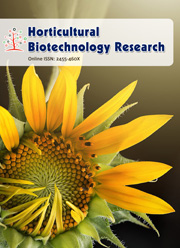Volatile metabolites profiling to discriminate diseases of tomato fruits inoculated with three toxigenic fungal pathogens
Keywords:
Disease detection, disease diagnosis, GC-MS, Metabolomics, post-harvest pathogensAbstract
The volatile metabolites of tomato fruits inoculated with three toxigenic fungi isolated from spoilt tomatoes were profiled using gas chromatography/mass spectrometry. Differences in the number and amount of volatile metabolites were observed. The study yielded a total of 52 different volatile metabolites. Healthy ripe tomato fruits yielded twenty-eight metabolites predominated among them were oleic acid amide (10.89%), 9-octadecenoic acid (9.83%), methyl cis-9-octadecenoate (7.73%), and the least was 2, 3-Heptanedione (0.32%). Tomato fruits inoculated with A. niger yielded 11; A. flavus yielded 15 different volatile metabolites while that inoculated with F. oxysporum yielded 8 volatile metabolites. Among them only 5 volatile metabolite occurred relatively consistent in fruits inoculated with A. niger and A. flavus while adogen 73 and 9-Octadecenoic acid (Z) occurred relatively consistently in fruits inoculated with the three fungi. Hexadecanoic acid and 6-Methyl-2,4-di - tert - butyl – phenol was common in fruits inoculated with F. oxysporum and A. niger with that of A. niger having the highest value (9.67%) for Hexadecanoic acid while fruits inoculated with F. oxysporum had highest (2.66%) for 6-Methyl-2,4-di - tert - butyl – phenol. Ten metabolites were unique to A. flavus while A. niger and F. oxysporum had 4 metabolites unique to each of them. This study suggests that these unique metabolites can be used as biomarkers to detect tomato diseases/pathogen or toxigenic fungi at an early stage of disease progression and to manage tomato diseases in storage and outbreak of food borne disease, after further validation under commercial conditions.Downloads
Download data is not yet available.
Published
18-06-2011
How to Cite
1Ibrahim, A., H., H., Sani, A., Aliero, A., & yakubu, S. E. (2011). Volatile metabolites profiling to discriminate diseases of tomato fruits inoculated with three toxigenic fungal pathogens. Research in Biotechnology, 2(3). Retrieved from https://updatepublishing.com/journal/index.php/rib/article/view/2354
Issue
Section
Research Articles



 .
.